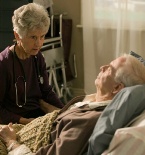Doctor Who?
 One of the most exciting things about working in patient safety and health care quality is that it’s not solely about advancing science or applying performance improvement methods. It is also about the excitement of being part of a social movement that is changing the culture of medicine—putting patients at the center of everything, sharing errors in the hopes of preventing future ones, and confronting hierarchies that stifle communication and innovation.
One of the most exciting things about working in patient safety and health care quality is that it’s not solely about advancing science or applying performance improvement methods. It is also about the excitement of being part of a social movement that is changing the culture of medicine—putting patients at the center of everything, sharing errors in the hopes of preventing future ones, and confronting hierarchies that stifle communication and innovation.
Kate Granger, a physician in the United Kingdom who is living with terminal cancer, has tapped into that sort of enthusiasm in a big way. Last summer, reflecting on a recent hospital admission, Granger remarked in her insightful blog that some members of her care team never introduced themselves when approaching her. She wrote:
As a healthcare professional you know so much about your patient. You know their name, their personal details, their health conditions, who they live with and much more. What do we as patients know about our healthcare professionals? The answer is often absolutely nothing, sometimes it seems not even their names. The balance of power is very one-sided in favour of the healthcare professional.
She asked that health care professionals make a pledge to introduce themselves to every patient that they meet, and share the challenge with others across the National Health Service. Thus was born a movement that went viral, aided by the Twitter hashtag #hellomynameis. More than five months since her post, there is a steady stream of tweets every day. Some clinicians wear lanyards with the hashtag, a show of support and a reminder to introduce themselves. Last week, NHS Employers released a video celebrating the #hellomynameis campaign.
More than anything, introducing yourself to patients is an issue of providing compassionate care. But it is also a patient safety issue. We know that faulty communication so often lies at the root of medical errors. How many adverse events might be prevented if all clinicians introduced themselves, making them more inviting to questions and concerns?Read More »Doctor Who?

 One of my colleagues, Nancy, recently shared a surprising experience that she had with her son—one of four children—as she was getting ready to send him off to college. The night before he left, this strapping, six-foot-tall man, who plays football and lacrosse, made an unusual request: He asked his mom to tuck him in to bed. When he returned home for a long weekend, he again wanted to be tucked in.
One of my colleagues, Nancy, recently shared a surprising experience that she had with her son—one of four children—as she was getting ready to send him off to college. The night before he left, this strapping, six-foot-tall man, who plays football and lacrosse, made an unusual request: He asked his mom to tuck him in to bed. When he returned home for a long weekend, he again wanted to be tucked in. I was reminded again recently of how important it is to sometimes just sit back and listen to what our patients have to say. Every month, as part of our hospital-wide patient safety efforts, I meet with staff and interview patients, seeking to learn how we can improve the care we provide to them.
I was reminded again recently of how important it is to sometimes just sit back and listen to what our patients have to say. Every month, as part of our hospital-wide patient safety efforts, I meet with staff and interview patients, seeking to learn how we can improve the care we provide to them.